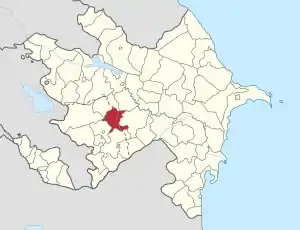Agdam
Agdam (Azerbaijani: Ağdam) is a ghost town and the nominal capital of Agdam District of Azerbaijan.[1] Founded in the early 19th century, it grew considerably during the Soviet period and had 39,200 inhabitants by 1991.[2]
Agdam
Ağdam | |
|---|---|
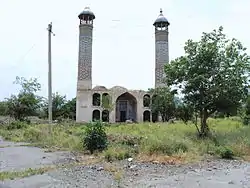 Juma mosque in Agdam (2010) | |
 Coat of arms | |
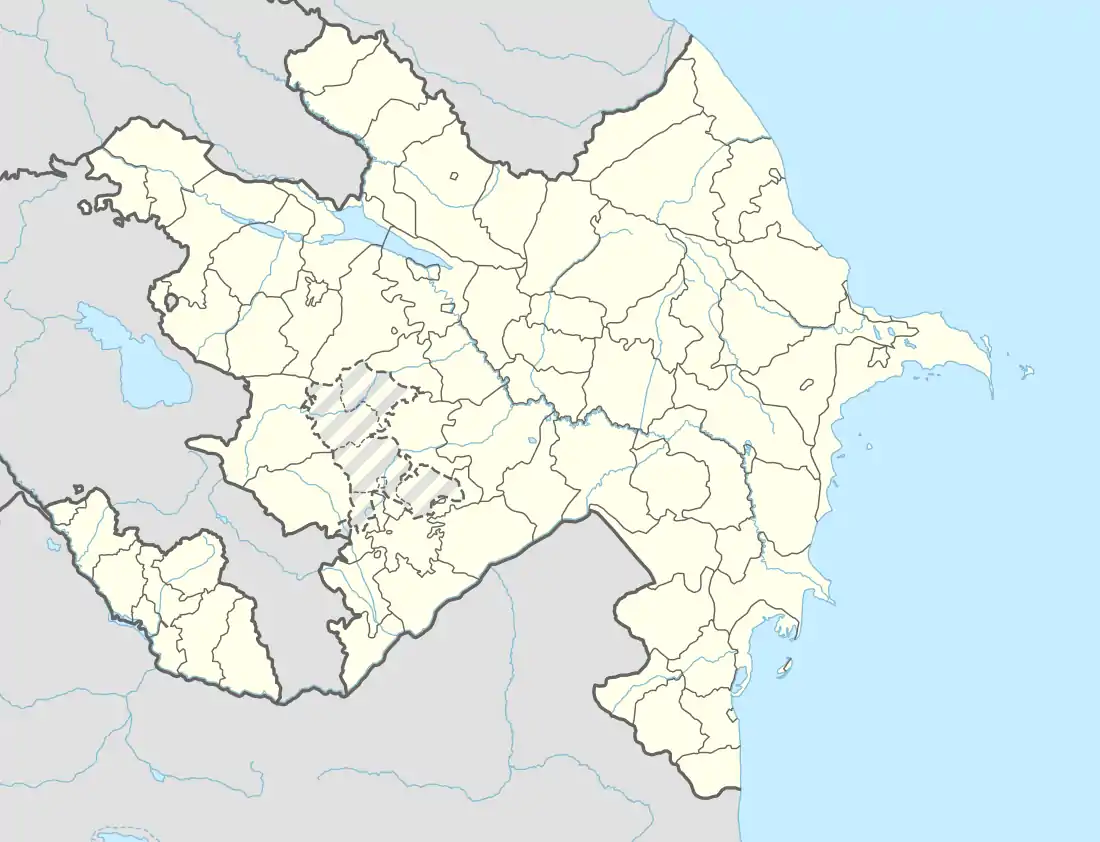 Agdam | |
| Coordinates: 39°59′35″N 46°55′50″E | |
| Country | |
| Rayon | Agdam |
| Elevation | 369 m (1,211 ft) |
| Population | |
| • Total | Currently uninhabited. The pre-conflict population was 39,200−78,000 |
| Time zone | UTC+4 |
| • Summer (DST) | UTC+5 |
Armenian forces captured Agdam in July 1993 during the First Nagorno-Karabakh War.[3] The heavy fighting forced the entire population to flee eastwards. Upon seizing the city, Nagorno-Karabakh Republic (NKR) forces destroyed much of the town to discourage Azerbaijanis from returning. More damage occurred in the following decades when locals looted the abandoned town for building materials. It is currently almost entirely ruined and uninhabited,[4] prompting the locals to refer to it as the Hiroshima of the Caucasus.[5][6] As part of an agreement that ended the 2020 Nagorno-Karabakh War the town and its surrounding district were returned to Azerbaijani control on 20 November 2020.[7][8]
Etymology
The city's name is of Azerbaijani origin, meaning "white house", where ağ means "white" and dam is "house" or "attic", thus referring to a "bright sun-lit, white house" which was given by Panah Ali Khan of the Karabakh Khanate.[9] Another possibility presented by Azerbaijani authors is that it was derived from ancient Turkic glossary meaning "small fortress".
In November 2010 it was renamed by the NKR government to Akna (Armenian: Ակնա).[10][11] Prior to the return to Azerbaijani control it was administratively part of the town of Askeran, which is located some 10 km away.[12]
History
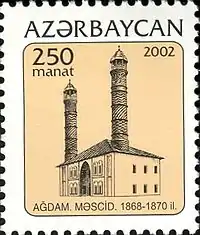
Agdam was founded in the 18th century and granted city status in 1828.[13] It is 26 km (16 miles) from Stepanakert (Khankendi). Before the First Nagorno-Karabakh War, butter, wine and brandy, machine, and silk factories, an airport and two railway stations functioned there.[14][15]
First Nagorno-Karabakh War
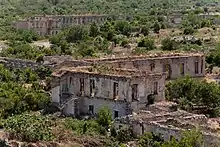
Agdam was the scene of brutal fighting in the First Nagorno-Karabakh War. According to journalist Robert Parsons, Azerbaijani forces used Agdam as a base for attacks on Karabakh, launching BM-21 Grad rockets and bombing raids from there against civilians.[16][17] As the city fell, almost its entire population fled eastward.[18]
The Armed Forces of Armenia used the city as a buffer zone until November 2020, as a result Agdam was empty, decaying, and usually off-limits for sightseeing.[19][20]
Armenian occupation
The ruined city once had a population of almost 40,000 people,[21] but today it is an almost entirely uninhabited ghost town.[22] One of the buildings stripped of materials was the Agdam Mosque, which had been converted into a barn for cattle and pigs.[23][24] In June 2010 Andrei Galafyev, a photographer who visited the mosque in 2007, reported that "The floor in the mosque is entirely dirtied with manure of cattle, which wander on the ruins of Agdam in the daytime."[25] His photographs showed cattle within the mosque.[26] Its derelict condition, including a missing roof, drew criticism from Azerbaijani and Turkish communities, who wrote a letter in 2010 to Pope Benedict XVI asking him to warn Armenians (though Armenians predominantly follow a church which broke with Rome in the 6th century) about the situation.[27]
Return to Azerbaijan
As part of the agreement that ended the 2020 Nagorno-Karabakh War the town and its surrounding area were returned to Azerbaijani control on 20 November 2020.[28]
On 24 November 2020, President of Azerbaijan Ilham Aliyev and his wife, Mehriban Aliyeva visited the ruined city and made a speech.[29]
Shortly after the return to Azerbaijani control, a big clean-up of the city began. It is predicted to take 2–5 years for people to be able to live in the city again and that the last landmines should be removed in 15 years' time.[30]
Geography
Climate
Agdam has a cold semi-arid climate (BSk) according to the Köppen climate classification.
| Climate data for Agdam | |||||||||||||
|---|---|---|---|---|---|---|---|---|---|---|---|---|---|
| Month | Jan | Feb | Mar | Apr | May | Jun | Jul | Aug | Sep | Oct | Nov | Dec | Year |
| Average high °C (°F) | 6.2 (43.2) |
7.0 (44.6) |
11.2 (52.2) |
18.6 (65.5) |
23.1 (73.6) |
27.8 (82.0) |
31.3 (88.3) |
30.1 (86.2) |
25.9 (78.6) |
19.1 (66.4) |
13.0 (55.4) |
8.6 (47.5) |
18.5 (65.3) |
| Daily mean °C (°F) | 2.3 (36.1) |
2.8 (37.0) |
6.1 (43.0) |
12.3 (54.1) |
16.1 (61.0) |
20.4 (68.7) |
24.6 (76.3) |
23.3 (73.9) |
18.6 (65.5) |
13.5 (56.3) |
8.2 (46.8) |
4.1 (39.4) |
12.7 (54.9) |
| Average low °C (°F) | −0.9 (30.4) |
0.0 (32.0) |
3.2 (37.8) |
8.9 (48.0) |
13.5 (56.3) |
17.8 (64.0) |
21.2 (70.2) |
20.0 (68.0) |
16.4 (61.5) |
10.6 (51.1) |
5.8 (42.4) |
1.5 (34.7) |
9.8 (49.6) |
| Average precipitation mm (inches) | 15 (0.6) |
24 (0.9) |
32 (1.3) |
48 (1.9) |
73 (2.9) |
64 (2.5) |
33 (1.3) |
27 (1.1) |
30 (1.2) |
50 (2.0) |
32 (1.3) |
19 (0.7) |
447 (17.6) |
| Average precipitation days | 4 | 6 | 7 | 7 | 10 | 7 | 3 | 3 | 4 | 6 | 5 | 4 | 66 |
| Source: NOAA[31] | |||||||||||||
Demographics
| Year | Population | Ethnic groups | Source |
|---|---|---|---|
| 1923 | 1,660 | [32] | |
| 1926 | 7,910 | 93.6% Azeri | Soviet census[33] |
| 1939 | 10,746 | 83.3% Azeri, 8.7% Russian, 5.3% Armenian | Soviet census[34] |
| 1959 | 16,061 | 92% Azeri, 3.6% Russian, 3.4% Armenian | Soviet census[35] |
| 1970 | 21,277 | 94.9% Azeri, 2% Russian & Ukrainian, 2% Armenian | Soviet census[36] |
| 1979 | 23,483 | 97% Azeri, 1.3% Russian & Ukrainian, 1.2% Armenian | Soviet census[37] |
| 1989 | 28,031 | Soviet census[38] | |
| 1991 | 39,200 | [32] | |
| 1993 | Estimated at around 52,000-78,000 due to Azerbaijanis fleeing from Armenia and Khojaly. Meshktian Turks also moved to Agdam. | 90-95% Azeri, 2-3% Mesktian Turks, 2-8% others | |
| 2005 | 0 |
Economy
Before the First Nagorno-Karabakh War, butter, wine and brandy, machine factories and a railway station functioned in the city.
Culture
Music and media
Mugham music, a tradition in the Karabakh region, is an important part of Agdam's musical heritage; the city was home to Agdam Mugham School, which produced "Karabakh nightingales" ensemble.[39][40]
Sport
Despite the invasion, the town is represented by a professional association football team competing in the top-flight of Azerbaijani football – Qarabağ FK, currently playing in the Azerbaijan Premier League.[41]
The Imarat Stadium, which was Agdam's only stadium, was also destroyed by bombardments from Armenian military forces during the First Nagorno-Karabakh War.[42][43][44]
Transport
Prior to the war, the city had bus and tram lines and an airport which no longer function.[45] In November 2020, Azerbaijan Railways announced that it was discussing plans to build a 104 km railway line from Yevlakh to Khankendi via Agdam.[46]
Education
Prior to the city's destruction and subsequent abandonment, it contained 74 schools, none of which are functioning now.
Notable residents
Some of the city's notable former residents include military commanders Allahverdi Bagirov and Asif Maharammov, footballers Ramiz Mammadov, Mushfig Huseynov and Vüqar Nadirov, mugham singers Gadir Rustamov, Mansum Ibrahimov, Arif Babayev and Sakhavat Mammadov, actor Jeyhun Mirzayev, scientist Zakir Mammadov and singer Roya.
See also
References
- Gai︠a︡nė Novikova (2004). The Nagorno Karabakh Conflict: In Search of the Way Out : To the Question of the Readiness of Azerbaijani and Armenian Societies to a Compromise Resolution of the Conflict. Amrots Group. p. 138. ISBN 9789994131273.
- "Cities & towns of Azerbaijan". pop-stat.mashke.org. Retrieved 2020-10-18.
- "Caucasus City Falls to Armenian Forces". The New York Times. 24 August 1993.
In July, Armenian forces forced out the defenders of Agdam, Azerbaijan.
- Specter, Michael (2 June 1994). "Azerbaijan, Potentially Rich, Is Impoverished by Warfare". The New York Times.
Cities like Agdam have been emptied of people.
- "The story of FK Qarabag: How a team born from war now prepares to host Chelsea in the Champions League". Independent.co.uk. 22 November 2017.
- Musayelyan, Lusine. "Life Among Ruins of Caucasus' Hiroshima". Institute for War and Peace Reporting.
- "Azerbaijanis celebrate Karabakh deal". aa.com.tr. Anadolu Agency. 10 November 2020.
- "Azerbaijan Army Enters Agdam As Armenians Flee". RadioFreeEurope/RadioLiberty. Retrieved 2020-11-20.
- "Agdam city". Ministry of Culture and Tourism of Azerbaijan. Archived from the original on 20 July 2012. Retrieved 26 July 2010.
- "Armenian separatists rename Azeri town". azernews.az. 3 November 2010.
- "July 23 marks 21st anniv.Aghdam liberation". PanARMENIAN.Net. 23 July 2014.
- Musayelyan, Lusine (26 April 2011). "Life Among Ruins of Caucasus' Hiroshima". Institute for War and Peace Reporting.
- Значение слова "Агдам" в Большой Советской Энциклопедии (in Russian). Soviet Encyclopedia. Retrieved 26 July 2010.
- Агдам (Азербайджан). Landmarkers.ru (in Russian). Archived from the original on 9 March 2012. Retrieved 26 July 2010.
- Girchenko, Yuriy. Юрий Гирченко. В Союзе все спокойно... (in Russian). Retrieved 26 July 2010.
- Parsons, Robert (3 June 2000). "Tug-of-war for Nagorno-Karabakh". BBC News. Archived from the original on 27 April 2010. Retrieved 26 July 2010.
- Human Rights Watch. Azerbaijan: Seven years of conflict in Nagorno-Karabakh. p.19.
- Paul, Amanda. "Agdam – an Azerbaijani ghost town". Archived from the original on 19 May 2011. Retrieved 18 May 2011.
- Hannigan, Chris. "Ghost Towns: Ağdam, Azerbaijan". Archived from the original on 13 August 2010. Retrieved 26 July 2010.
- Chauffor, Célia. "Report: Agdam, ghost city". Caucaz Europenewz. Archived from the original on 1 July 2010. Retrieved 26 July 2010.
- "Azerbaijani cities".
- "20 Abandoned Cities from Around the World". Daily Cognition. Retrieved 26 July 2010.
- Carlotta Gall and Anton Troianovski (11 December 2020). "After Nagorno-Karabakh War, Trauma, Tragedy and Devastation". The New York Times. Retrieved 12 December 2020 – via nytimes.com.
- Qureshi, Shahid (13 July 2020). "Armenians converted 'Aghdam Jamia Mosque' into Pigsty in Occupied Qarabakh – why no Protests?". The London Post. The London Post. Retrieved 3 December 2020.
- "Велопоход по Армении и Нагорному Карабаху 2007". bestandreyspb.narod.ru. Retrieved 2020-11-23.
- Qureshi, Shahid (13 July 2020). "Armenians converted 'Aghdam Jamia Mosque' into Pigsty in Occupied Qarabakh – why no Protests?". The London Post. Retrieved 3 December 2020.
- "Turks complain to Pope on vandalism in Karabakh mosque by Armenians". Archived from the original on 20 July 2010. Retrieved 26 July 2010.
- "Azerbaijanis celebrate Karabakh deal". aa.com.tr. Anadolu Agency. 10 November 2020.
- "President Ilham Aliyev and First Lady Mehriban Aliyeva visited the liberated city of Agdam". apa.az. 24 November 2020.
- "Nagorno-Karabakh: Tough rebuilding ahead for devastated city of Agdam". France 24. 2020-11-28. Retrieved 2020-11-28.
- "Agdam Climate Normals 1961–1990". National Oceanic and Atmospheric Administration. Retrieved 22 March 2015.
- "Azərbaycan". pop-stat.mashke.org.
- "Агдамский уезд 1926". ethno-kavkaz.narod.ru.
- "Агдамский район 1939". ethno-kavkaz.narod.ru.
- "Агдамский район 1959". ethno-kavkaz.narod.ru.
- "Агдамский район 1970". ethno-kavkaz.narod.ru.
- "Агдамский район 1979". ethno-kavkaz.narod.ru.
- "Archived copy". Archived from the original on 2014-02-22. Retrieved 2014-06-03.CS1 maint: archived copy as title (link)
- Shirinov, Elnur. ""Qarabağ bülbülləri" nin yaradıcısı kimdir". Retrieved 14 November 2014.
- Золотой голос Карабаха – Гадир Рустамов. karabakhinfo.com (in Russian). Archived from the original on 22 December 2015. Retrieved 14 November 2014.
- Adil Nadirov: «Bizi az qala döyüb öldürəcəkdilər" Archived 2016-03-19 at the Wayback Machine (20 April 2010) (in Azerbaijani)
- Vaxt olmayan yer (in Azerbaijani) Archived July 6, 2011, at the Wayback Machine
- Ermənilərin xarabaya çevirdiyi Ağdamın «İmarət» stadionu Archived 2016-03-22 at the Wayback Machine (8 June 2010) (in Azerbaijani)
- "Caqa" ikinci dəfə lotereyada uddu (in Azerbaijani) Archived July 6, 2011, at the Wayback Machine
- "Ağdam". virtualkarabakh.az (in Azerbaijani). Archived from the original on 2017-03-02.
External links
| Wikimedia Commons has media related to Agdam. |
| Wikivoyage has a travel guide for Agdam. |
- Aghdam: This is no Hiroshima
- Fleeing from Aghdam. Refugee poem
- World Gazetteer: Azerbaijan– World-Gazetteer.com
- Pictures of the deserted town: "Abandoned War-Torn City of Agdam, Azerbaijan"
- Pictures of the deserted town: "Aghdam"
- "Clashes Intensify Between Armenia and Azerbaijan Over Disputed Land". The New York Times. January 31, 2015.

